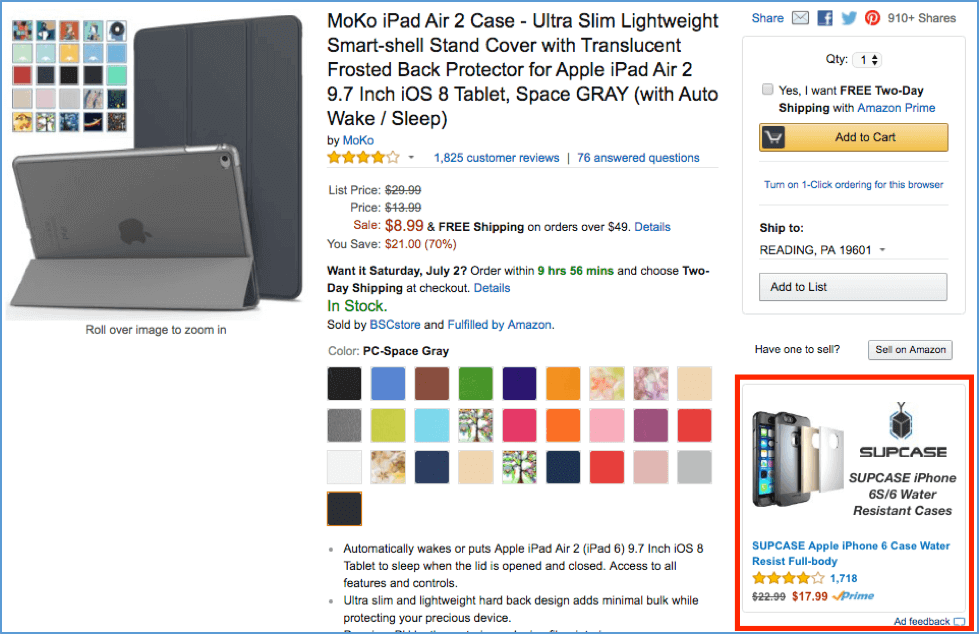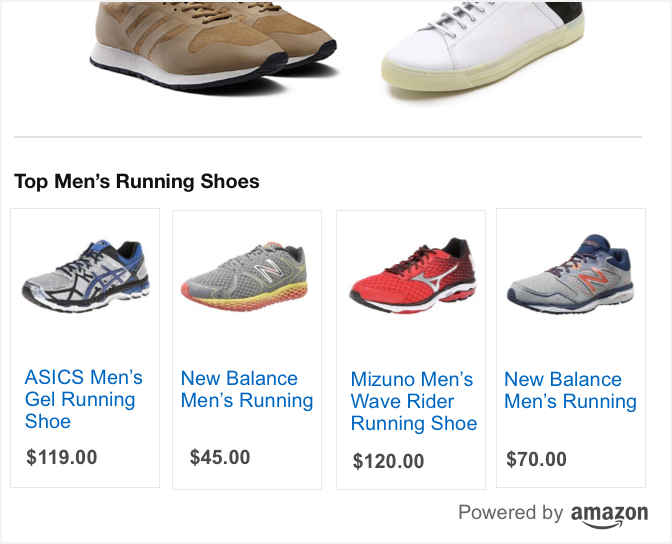In 2018, the advertising duopoly of Google and Facebook seemed to dominate the market once again, owning 37% and 20% of the pie, respectively, while Amazon owned a measly 7%. However, if you dig a little deeper into the numbers, Amazon isn’t actually the third wheel in this equation.
While they own significantly less market share than Google and Facebook, Amazon’s advertising revenue skyrocketed by 250% in the third quarter of 2018 compared to the third quarter of 2017. And some industry experts predict that the long-standing advertising duopoly of Google and Facebook will turn into a triopoly as soon as next year, with Amazon charging right behind these established incumbents.
One of the biggest reasons brands are dedicating more advertising spend to Amazon is because it has become the central hub for online shopping. In fact, 44% of shoppers start their online shopping sessions on Amazon (which is 11% more than Google) and 40% of Americans buy products on the website at least once every month.
If you’re in the ecommerce industry, advertising on Amazon is your best bet for maximizing your revenue. So to help you start advertising on Amazon, we’ve created this simplified guide that fleshes out each type of ad you can run on Amazon and some of their best practices. Read on to learn how to advertise on the eCommerce platform in 2019.
Amazon Advertising Strategy
Even though we’ll be describing five unique types of Amazon advertisements that all have different best practices, here are three general tips for shaping a successful Amazon advertising strategy.
1. Determine your goals.
Whether you want to drive more sales or boost brand awareness, Amazon allows you to align your targets with your goals. For instance, you can deem your Advertising Cost of Sales (ACoS) as your metric of success if you’re focusing on driving more sales. Alternatively, you can deem impressions as your metric of success if you’re focusing on boosting brand awareness.
2. Choose the right products to advertise.
Advertising your most popular products gives you the best chance to convert clicks into purchases. You should also make sure these products are in stock and priced competitively.
3. Craft clear, concise, and compelling product detail pages.
Amazon ads can entice shoppers to visit your product detail pages, but the product detail page is what will ultimately turn those shoppers into customers. To craft a persuasive product detail page, consider including accurate and descriptive titles, high-quality images, and relevant and useful product information.
Amazon Sponsored Ads

Image Credit: Shopify
Amazon Sponsored Product Ads are pay-per-click, keyword-targeted display ads for individual products that appear on search results and product detail pages. With Sponsored Product Ads, there are three types of keywords you can bid on if you decide to leverage manual targeting: broad, phrase, and exact.
Broad keywords can include words before and after the target keyword, like “white hand mixers”, if you sell hand mixers. Targeting these keywords will expose your ads to the greatest amount of traffic.
Phrase keywords focus on how the sequence of the words you use changes the context of a query. For example, “stainless steel hand mixer” indicates you sell hand mixers. But “hand stainless steel mixer” indicates you sell stainless steel mixers, but not necessarily stainless steel hand mixers.
Exact keywords are the most constraining type of targeted keyword -- a shopper’s search query must contain the exact keyword for your ad to show up and no words can come before or after the keyword. For example, if you choose to target exact keywords, you can target an ad for “hand mixer”, but it won’t show up for the query “electric hand mixer”.
Using Sponsored Product Ads, you can also use automatic keyword targeting, which leverages an algorithm to target the most relevant keywords for your product ads.
To gauge the performance of your ads, Sponsored Product Ads offers a reporting tool that displays your ads’ clicks, spend, sales, and advertising cost of sales (ACoS).
Amazon Sponsored Ads Best Practices
Targeting
With Amazon Sponsored Product Ads, you can find keywords that have low conversion rates and flag them as negative. This way, Amazon will stop showing your ad to shoppers who search for those queries. Ensuring you flag certain keywords as negative is critical -- even if these keywords have a high click-through-rate, their low conversion rate means they’re probably not reaching the right type of shoppers.
Bidding
Available in Manual Targeting ad campaigns, you can leverage Bid+ to boost the odds of your ad appearing at the top of search results. You can only use Bid+ on ads that are eligible to appear at the top of search results, but when you do, you can increase your default bid by up to 50%, keeping your top performing campaigns competitive, without having to constantly adjust your bids manually.
Amazon Headline Search Ads (Now Known as Sponsored Brand Campaigns)
-12.png)
Image Credit: Amazon Advertising
Currently known as Sponsored Brand Campaigns, this type of Amazon advertising allows you to promote keyword-targeted ads of multiple products above, below, and alongside search results. Using Sponsored Brand Campaigns, you can target three types of keywords: branded product keywords, complimentary product keywords, and sponsored products automatic targeting keywords.
Branded product keywords are a combination of your brand name and a product you sell.
Complimentary product keywords are a bundle of two individual products that influence the demand for each other and can be sold together (like ketchup and mustard).
Sponsored products automatic targeting keywords are search queries that you’ve already experienced success with while running automatic targeted sponsored product campaigns.
Sponsored Brand Campaigns also lets you feature up to three unique products in your ads, customize your ads’ image, headline, and landing page, and even tests these elements.
To determine how much you pay for Sponsored Brand Campaigns, Amazon uses a pay-per-click, auction-based pricing model, so you’ll never pay more than you bid per click. In addition to manual bidding, you can choose automated bidding, which will optimize your ads for conversion.
If you want to know how well your advertisements are performing, Sponsored Brand Campaigns offers a reporting feature that displays your ads’ clicks, spend, sales, estimated win rate for keywords, and ACoS (Advertising Cost of Sales).
Sponsored Brand Campaigns Best Practices
Ad Creative
It's a good idea to feature three top-performing products in your Sponsored Brands Campaign to increase the amount of clicks and sales your ads generate.
Amazon also recommends including your product’s top benefit in your ad’s headline because mobile shoppers can only see the ad’s main image and headline.
Additionally, when describing your product, try not to claim your product is “#1” or a “Best Seller” -- your ad won’t get approved.
Testing
To run the most accurate and fruitful tests, consider only changing one variable at a time, run them for at least two weeks, and anchor the success of your tests to business goals.
Landing Page Design
With Sponsored Brands, you can direct shoppers to your Amazon store or a customized product page. Consider testing how different product pages convert visitors into customers, as well as the order in which your products appear.
Amazon Product Display Ads
 Image Credit: CrazyLister
Image Credit: CrazyLister
Product display ads are pay-per-click ads that appear on product detail pages, customer review pages, on top of the offer listing page, and below search results. You can also place these ads on abandoned cart emails, follow-up emails, and recommendations emails. Their main objective is to cross-sell or upsell your customers.
Using product display ads, you can use two types of campaign targeting: product and interest. Product targeting is a contextual form of targeting, so you can target specific products and related categories. Interest targeting is a behavioral form of targeting, so you can target shopper interest and reach a larger audience.
Product display ads also let you choose which in-category detail pages you want to advertise on, customize your creative, and offers a reporting tool that displays your campaigns’ clicks, spend, sales, advertising cost of sales (ACoS), detail page views, spend, units sold, total sales, and average cost-per-click (ACPC).
Amazon Product Display Ads Best Practices
Targeting
Use product targeting on competitor pages, complimentary product detail pages, and your own product detail pages to cross-sell and upsell similar products. Using product targeting on related categories also extends your reach to sections of Amazon’s catalog that are related to your products.
Ad Creative
When crafting your headlines, Amazon allows you to include phrases like “Exclusive”, “New”, “Buy Now”, and “Save Now”, but making claims like “#1” or “Beat Seller” will get your ad rejected.
Amazon Native Ads
Amazon Native Ads are ads that you can place on your brand’s own website. There are three types of native ads: recommendation ads, search ads, and custom ads.
Recommendation ads are ads you can place in product article pages on your website. These ads are dynamic, so Amazon will populate your most relevant product recommendation based on your web page’s content and visitors.
-9.png)
Image Credit: Amazon Associates
Search ads are ads that populate on your website based off keywords that your customers search for on Amazon or on your website.
-8.png)
Image Credit: Amazon Associates
Custom ads allow you to select your own assortment of products you’d like to promote and place them on your product article posts.

Image Credit: Amazon Associates
Amazon Native Ads Best Practice
Just like a call-to-action on a blog post, make sure your native shopping ads are extremely relevant to the pages you place them on. This way, when your website visitors finish reading your post, the ads are a natural next step and can lead to more conversions.
Amazon Video Ads
Amazon Video Ads are ads that you can place on Amazon-owned sites like Amazon.com and IMDb, Amazon devices like Fire TV, and various properties across the web. You can buy Amazon video ads regardless of whether you sell products on Amazon or not, and you can set your ad’s landing page as an Amazon product page, your own website, or any other web page on the internet.
-7.png)
Image Credit: Amazon Advertising
If you want to work with Amazon’s video ad consultants, you can sign up for their managed-service option, but to be eligible, you usually need to spend a minimum of $35,000 on video ads.
No comments:
Post a Comment